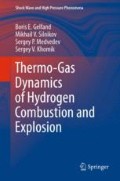Abstract
The dreadful accidents at Three-Mail Island and the Chernobyl nuclear power plant gave a powerful incentive to investigate combustion and concentration limits of flame propagation in hydrogenous mixtures with high steam content at high temperatures and pressures. Analysis of results obtained during large–scale experiments has revealed the fact that the concentration limits of the fast combustion regimes, the deflagration-to-detonation transition and the detonation limits broaden towards leaner mixtures. However, the combustion concentration limit values obtained in laboratory-like environments are also of use.
Access this chapter
Tax calculation will be finalised at checkout
Purchases are for personal use only
References
A.L. Furno, E.B. Cook, J.M. Kuchta, D.S. Burgess, Some observations on near-limit flames. Proc. Combust. Inst. 13, 593–599 (1971)
M.G. Zabetakis, Flammability characteristics of combustible gases and vapors. Bulletin 627, Bureau of Mines, Washington, DC, 1965
M.G. Zabetakis, Research on the combustion and explosion hazards of hydrogen-water mixtures. Report AECU-3327, Bureau of Mines, Pittsburgh, 1956
M. Hertzberg, Flammability limits and pressure development in H2-air mixtures. Pittsburgh Research Center, PRC Report 4305, 1981
H. Tamm, R.K. Kumar, W.C. Harrison, A review of recent experiments at WNRE on hydrogen combustion, in Proceedings of the 2nd International Conference on the Impact of Hydrogen on Water Reactor Safety, Albuquerque, 1982, ed. by M. Berman, J. Carey, J. Larkins, L. Thompson (Technical Program Commission) NUREG/CR-0038, SAND82-2456
M. Berman, J.C. Cummings, Hydrogen behavior in light-water reactors. Nucl. Safety 25, 53–74 (1984)
R.K. Kumar, G.W. Koroll, Hydrogen combustion mitigation concepts for nuclear reactor containment buildings. Nucl. Safety 33, 398–414 (1992)
R.K. Kumar, Flammability limits of hydrogen-oxygen-diluent mixtures. J. Fire Sci. 3, 245–262 (1985)
B.W. Marshall Jr., Hydrogen-air-steam flammability limits and combustion characteristics in the FITS vessel. NUREG/CR-3468, SAND84-0383, 1986
S.M. Kogarko, A.G. Lyamin, O.E. Popov, A.Y. Kusharin, A.V. Dubrovin, Determination of flame propagation limits in stoichiometric oxyhydrogen mixtures with steam, in Hydrogen Behavior and Control and Related Containment Loading Aspects. IAEA-TC-476.6, Vienna, pp. 37–41, 1984
Y.N. Shebeko, S.G. Tsarichenko, A.Y. Korolchenko, A.V. Trunev, V.Y. Navzenya, S.N. Papkov, A.A. Zaitzev, Burning velocities and flammability limits of gaseous mixtures at elevated temperatures and pressures. Combust. Flame 102, 427–437 (1995)
A.B. Tpунeв, Oбecпeчeниe вoдopoднoй пoжapoвзpывoбeзoпacнocти пoмeщeний и тexнoлoгичecкoгo oбopудoвaния мeтoдoм нeйтpaлизaции. Диccepтaция к.т.н., BHИИПO MBД, Бaлaшиxa, 1994 (A.V. Trunev, Ensuring hydrogen fire safety of housing and technology equipment via neutralization. Dissertation k.t.n., VNIIPO MVD, Balashiha, 1994)
A.Y. Kusharin, O.E. Popov, G.L. Agafonov, Combustion and shock waves in H2-O2-steam systems, in Proceedings of the 19th ISSW, vol. 2, ed. by R. Brun, L.Z. Dumitrescu (Springer, Berlin, 1995), pp. 143–148
A.Y. Kusharin, O.E. Popov, G.L. Agafonov, Initiation of laminar flames in near-limit H2/O2/H2O mixtures. Proc. Combust. Inst. 26, 985–991 (1996)
V.A. Bunev, Determination of the concentration limits of flame propagation at elevated temperatures. Combust. Explos. Shock Waves 8(1), 67–69 (1972)
I. Wierzba, B.B. Ale, Effects of temperature and time of exposure on the flammability limits of hydrogen-air mixtures. Int. J. Hydrogen Energy 23, 1197–1202 (1998)
I. Wierzba, V. Kilchyk, Flammability limits of hydrogen-carbon monoxide mixtures at moderately elevated temperatures. Int. J. Hydrogen Energy 26, 639–643 (2001)
V. Schroeder, K. Holtappels, Explosion characteristics of hydrogen-air and hydrogen-oxygen mixtures at elevated pressures, in International Conference on Hydrogen Safety, Pisa, CD-ROM publication, paper 120001, 2005
H.F. Coward, G.W. Jones, Limits of flammability of gases and vapors. Bulletin 503, Bureau of Mines, Washington, DC, 1952
F. Schoor, F. Norman, R. Vandermeiren, J. Berghmans, E. Buick, Flammability limits, limiting O2 concentration and minimum inert gas/combustible ratio of H2/CO/N2/Air mixture. Int. J. Hydrogen Energy 4(4), 2069–2075 (2009)
B. Lewis, G. von Elbe, Combustion, Flames and Explosion of Gases, 3rd edn. (Academic, Orlando, 1987). 739 p
G.A. Karim, I. Wierzba, S. Boon, Some considerations of the lean flammability limits of mixture involving hydrogen. Int. J. Hydrogen Energy 10, 117–123 (1985)
I. Wierzba, G.A. Karim, H. Cheng, The rich flammability limits of fuel mixtures containing hydrogen. Am. Inst. Chem. Eng. 82, 251 (1986)
I. Wierzba, Q. Wang, The flammability limits of H2-CO-CH4 mixtures in air at elevated temperatures. Int. J. Hydrogen Energy 31, 485–489 (2006)
I. Wierzba, B.B. Ale, Rich flammability limits of fuel mixtures involving hydrogen at elevated temperature. Int. J. Hydrogen Energy 25, 75–80 (2000)
V.V. Azatyan, Y.N. Shebeko, A.Y. Shebeko, V.Y. Navzenya, A.V. Tomilin, An influence of oxygen content in an oxidizing atmosphere on inhibitive action of fluorinated agents on hydrogen flame. Paper at the 6th international symposium on hazards, prevention and mitigation of industrial explosions, Canada, 2006
J.A. Syage, E.W. Fournier, R. Rianda, R.B. Cohen, Dynamics of flame propagation using laser-induced spark initiation: Ignition energy measurements. J. Appl. Phys. 64, 1499–1507 (1988)
M.R. Swain, P.A. Filoso, M.N. Swain, Ignition of lean hydrogen-air mixtures. Int. J. Hydrogen Energy 30(13/14), i447–i455 (2005)
R.A. Strehlow, Combustion Fundamentals (McGraw-Hill, New York, 1984)
R. Pritchard, J.J. Guy, N.B. Connor, Handbook of Industrial Gas Utilization (Van Nostrand Reinhold, New York, 1977)
R.M. Fristrom, A.A. Westenberg, Flame Structures (McGraw-Hill, New York, 1965)
L.M. Das, Hydrogen-oxygen reaction mechanism and its implication to hydrogen engine combustion. Int. J. Hydrogen Energy 21, 703–715 (1996)
A. Teodorczyk, Fast deflagrations, deflagration to detonation transition (DDT) and direct detonation initiation in hydrogen-air mixtures. Paper at 1st European Summer School on Hydrogen Safety, Belfast, August, 2006
M.C. Ross, J.E. Shepherd, Lean combustion characteristics of H2+N2O+NH3 mixtures in air. EDL report FM96-4.1996.CalTech, 1996
Author information
Authors and Affiliations
Rights and permissions
Copyright information
© 2012 Springer-Verlag Berlin Heidelberg
About this chapter
Cite this chapter
Gelfand, B.E., Silnikov, M.V., Medvedev, S.P., Khomik, S.V. (2012). Concentration Limits of Flame Propagation. In: Thermo-Gas Dynamics of Hydrogen Combustion and Explosion. Shock Wave and High Pressure Phenomena. Springer, Berlin, Heidelberg. https://doi.org/10.1007/978-3-642-25352-2_4
Download citation
DOI: https://doi.org/10.1007/978-3-642-25352-2_4
Published:
Publisher Name: Springer, Berlin, Heidelberg
Print ISBN: 978-3-642-25351-5
Online ISBN: 978-3-642-25352-2
eBook Packages: Physics and AstronomyPhysics and Astronomy (R0)

